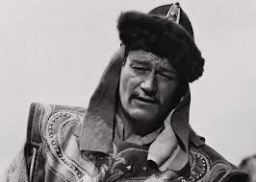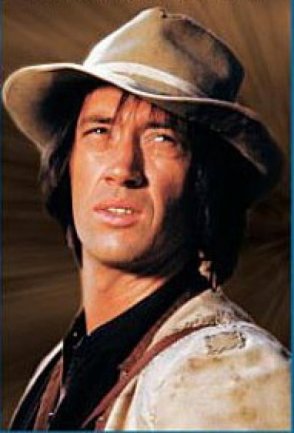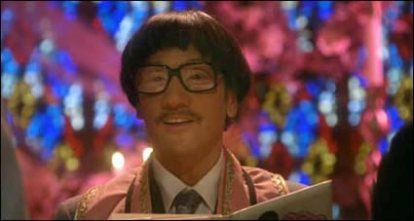
I’m not posting pictures of the actual minors in the show. Instead I’m choosing to post pictures from America’s vast yellowface past. This keeps the kids’ identities confidential while also providing some cultural context.
Someone I know recently posted some pictures of her son’s high school performance of A Midsummer Night’s Dream. Of course I’m stoked that the kids are doing Shakespeare instead of Grease or One Direction: The Musical or whatever. And I definitely understand the impulse to want to set these plays in a fanciful place and time, especially if you have hundreds of hours of free parental labor and thousands of dollars at your disposal. I’m not a huge fan of randomly chosen settings, like Love’s Labour’s Lost in an 18th century brothel or King Lear on the Death Star (although I might have to give that last one some serious thought). But I understand the impulse, even if I do not agree with it.
The problem with this play is that it’s set in “Ming Dynasty China.”
I’ve written about race in casting before (this and this). But I’ve been thinking about this issue all day, for two reasons: One, the fact that this is educational theatre; and two, that half the kids in the cast are Asian American, but the faculty director is white.
There’s a reason theatre education belongs in schools. It teaches kids about the challenges and joys of creating art collaboratively. It helps kids learn how to extract meaning from text in very concrete ways. It teaches kids how to work under an utterly unforgiving deadline. It teaches kids about the massive, gorgeous, messy pile of dramatic literature available to us in the 21st century, which are all windows open to different places, times, experiences, and points of view. Theatre education is a life-changing, mind-expanding experience.
This is precisely why this is so disappointing to me. These kids are being taught that it’s acceptable for white people to play characters of color. It’s nowhere near acceptable in the professional world, where a mistake like that can create national controversy. If you don’t have an all-Asian cast at your disposal, you shouldn’t be doing a play set in Ming Dynasty China, and to place high school kids into such a situation is to do them a huge disservice. There’s a reason why I’m not posting pictures of these kids. This is not their fault, and I’m not holding them up to global mockery. It’s easy to say, “What does it matter? It’s just high school theatre.” If that’s the case, then what does ANY educational activity matter? Why not blow it all off and let them all play CoD: Ghosts instead of reading Catcher in the Rye or doing those calculus problems? I guarantee you that the skills theatre kids are learning are more likely to be useful to them in their future day-to-day lives as adults than calculus will be. If you believe education is important, then it follows that teaching kids that something highly controversial and racially problematic is just fine is shockingly irresponsible. Either education matters or it does not.
Midsummer is a play people love to set in various places, and it can be quite successfully done that way. Bindlestiff Studio in San Francisco did an all-Filipino Midsummer using Filipino folklore tropes, with Tagalog-speaking mechanicals that was so fantastic I saw it TWICE. Which is insane, since I rarely get out of my own theatre. But this was a Filipino production, headed by a Filipino director, with an all-Filipino cast, at a Filipino theatre. This was about taking ownership of a classic story, coming from a deep, authentic positionality. A white director setting Midsummer in Ming Dynasty China with a half-white cast is not the same (especially when that cast are all teenagers working under an adult authority figure who makes the bulk of the creative decisions). It doesn’t have a deep message that comes from the center of Chinese or Chinese American culture. Instead, it’s a white director using a non-white culture as WINDOW DRESSING. And no matter how much research was done, or how many accurate renderings of period costumes or sets there were, this was using a culture as decoration, not marginalized people telling a story from within that cultural positionality. It’s deeply problematic.
When I first started discussing this issue, I was told that half the cast is Asian, some of the techs are Asian, and the faculty choreographer is Asian. I was told that the Asian families coming to see their kids in the show weren’t complaining about the yellowface (out loud). I was told that the performances weren’t “stereotypical,” and that someone was playing traditional Chinese music during the show. I was told that the casting was “multicultural.” These were all held up to me as reasons it’s OK for white kids to play people of color. I actually gave it some thought. After all, the kids were in traditional Beijing Opera makeup, not actual yellowface . . . did that matter? And I wondered for a bit if the presence of Asians working on the show changed the equation at all.

Oh, right. No, it doesn’t. Not even an Asian director makes a difference in the ensuing controversy apart from: “He should have known better.”
It’s just not acceptable for white people in America to play people of color at all. Race has meaning. And although I suppose it could be argued that a half-white cast isn’t as egregious as a fully-white cast, or one wherein all the leads are white, race still carries narrative that cannot be erased. The meaning of a white person playing an Asian person is culturally problematic in profound, complex ways attached to a lengthy history of appropriation, erasure, and oppression. It’s a common misconception that “multicultural casting” means that white people should be able to play characters of color because we cast people of color in roles originally written for white actors. To pretentiously quote my own damn article that I linked to above (see, now you don’t have to click on it):
Using a white actor as [a character of color] has a very different impact on the narrative than casting a person of color in a traditionally white role. It erases the physical presence of the person of color and substitutes it with blackface/yellowface, imperialism and cultural appropriation. The West has a long history of casting white actors in racist portrayals of people of color, of appropriating the narratives of people of color and reshaping them through a white lens, and of shutting artists of color out of positions of importance. An American audience viewing a white person portraying a person of color will be reminded of all of these, and of blackface, of yellowface, of the history of racism with which we still struggle. These are all present in any production wherein a white actor is cast as a person of color because they are so palpably present within our culture. Again, race is always part of the narrative.
Maybe it’ll change some day, and we will be so many hundreds of years past the issues that make yellowface culturally unacceptable that it truly will not matter any longer, because race will no longer carry the same narratives it does now. Perhaps it’ll carry new, better narratives, less painful, less difficult. But that day is not today, and both yellowface and whitewashing remain culturally unacceptable.
I’m not going to reveal the location of this production, and I won’t approve any comments that do, because at its heart, this is about protecting those kids. They should be taught right from wrong, and yellowface is wrong, just as all whitewashing is wrong. In our current cultural context, it’s never OK for a white person to play a person of color, even in a high school. ESPECIALLY in a high school. And claiming that it’s OK because there are Asians in the room is like the guy who says “My Black friend LOVES my racist jokes.” Whether it’s true or not, the jokes are still racist, and there is a much larger cultural context to consider.




Melissa, you are incredibly perceptive and insightful. I always feel like I’ve learned something after reading you, talking to you, watching your productions. Thank you for making me think. I hope someday soon someone will pay a lot of money for your opinions.
“It doesn’t have a deep message that comes from the center of Chinese or Chinese American culture. Instead, it’s a white director using a non-white culture as WINDOW DRESSING.”
I guess it all hinges on this question. If I were to give the director the benefit of the doubt, I would assume that he had some intention in setting the play in Ming Dynasty China. But I would have to see the play to make that determination.
It’s an interesting question, and one that is hotly debated in theatre communities: Can a white director speak with authenticity about the experiences of people of color? Even if the answer is yes, does the cultural context of hundreds of years of erasure and appropriation outweigh that?
There are multiple sides to these issues. I don’t think it’s always a simple answer. Issues of cultural authenticity and appropriation can be very emotional on both sides. People of color are still suffering under daily erasure and appropriation– a quick look at the Akira controversy will reveal much. I think the best we can do is to pay close attention to the cultural context of the things we choose to stage.
Beautifully written, but I fear the extension of this argument in an educational institution. The ramifications could be that the Asian students, who make up half of the participants, will not be given a chance to perform anything that represents their culture or background. There are fantastic non-Western stories and theatrical traditions, but they have to keep doing Western classics set in Western countries as they’re allowed to participate in those and the white kids can’t participate in non-Western theater. The alternative is to segregate them and say if they want to do non-Western work they don’t get to do it with their white classmates. Either alternative seem egregious to me and gives the impression that theater is not relevant to non-white students. In my book that would be possibly the worst thing a theater teacher could do.
You’re misunderstanding. White kids can absolutely participate in non-Western theatre. You just don’t put them in racist drag to do it, and you don’t take a Western play and randomly decide to appropriate a non-Western culture for your design choices.
If you want to do a classic play from a particular non-Western culture because you have a bunch of students from that culture, that’s great. Choose a non-Western play that already has diverse characters or supports diverse characterizations (many non-Western plays contain characters such as monsters, ghosts, and animals, as well as supporting characters that can be any race), or let your white kids take that quarter to get their crew credits done.
Also, there are many, many plays written by contemporary playwrights of color that have white characters in them, or characters whose race is unspecified. There are literally HUNDREDS of plays like these. Familiarize yourself with the new generation of playwrights of color and see what I mean.
You can have it both ways– you can do plays by playwrights of color AND you can avoid putting white actors in yellowface, blackface, or brownface, even in an educational setting. IT CAN BE DONE.
Bravo!
Tweeting this.
Have you seen the “reality” show where they put people in professional movie grade makeup and see how people react when they think they are a different color? It basically proves everybody is judgemental upon first meeting someone. When I was in grade school some kids did a Chubby Checker Twist cover at a school talent assembly and my 2nd grade teacher had the “brilliant” idea of rubbing cocoa powder on their faces. This was in the 80s. I’m sure if there had been even one black kid at our school they would have gotten the part but there probably still would have been 3 cocoa dusted faces onstage because that’s what they were working with.